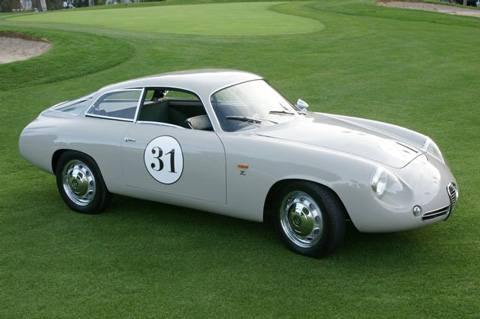
Best of Show was chosen from the class winners by a panel of designers. The winner was Scott and Courtney Gauthier’s Alfa Sprint Zagato Coda Tronca. Less than two hundred were made, but only about 30 had this Kamm-tail configuration. Credit: Gregg Felsen
The Desert Classic Concours Continues to Impress
By Michael T. Lynch
The second edition of the Palm Springs Desert Classic Concours d’Elegance took place under clear skies with temperatures in the low 80s on March 1st. Organizers Paul and Holly Merrigan took a note from the Obama playbook and had a stimulus package of their own, expanding last year’s schedule dramatically.
It began with an opening reception and buffet at the Heather James Gallery in Palm Desert on Friday night. Owner Jim Carona, admittedly not a car guy, wanted to help promote the event for the tourism it brings to the area. His gallery had a Bugatti Type 57 Stelvio drophead on display in the week leading up to the Concours. With tongue in cheek, he complained, “All week, the car got more attention than the works I”m showing by famous artists.”

You don’t often see one of these on the street, but Bill Pope’s exceptional Maserati 6CM was out in the countryside on Saturday with the rest of the Desert Classic Tour participants. Credit: John Wiley.
Saturday morning saw a tour that began at the Palm Springs Art Museum and concluded at Cuistot Restaurant in Palm Desert. The host there was Bernard Dervieux, a well-known restaurateur, vintage racer and collector. Some concours cars were displayed on El Paseo nearby. The avenue is sometimes known as the Rodeo Drive of the desert and the merchants outdid themselves with refreshments and hors d’oeuvres, to the delight of the shoppers and gawkers.
Late in the afternoon, there was an automotive design lecture at the Palm Springs Museum of Art. Presenting were the father and son team of Ron and Jason Hill. Both are graduates of the Art Center School of Design, now in Pasadena, long the provider of most of the world’s leading automotive designers. The elder Hill had a long and distinguished career at General Motors before returning to the Art Center to head the Transportation Design Department. Jason worked for Mercedes and Porsche before he too, returned to the Art Center as an instructor. Jason has also built himself as a reputation as a green designer, and a product of his company, the Aptera electric car, was shown in an electric car class at the Concours. Needless to say, their presentation, spanning 50 years of automotive history, was fascinating.
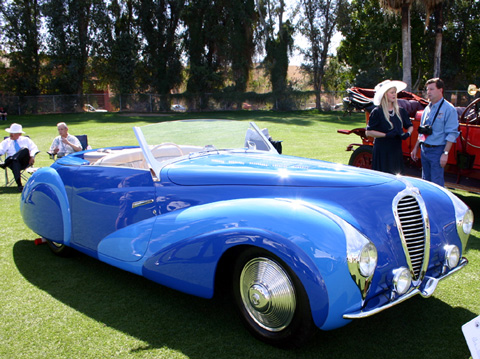
No concours can claim to be first class without some great French swoopy bodywork. Cathy Gauche stands beside her Delahaye 135 MS Faget-Varnet Cabriolet. The killer set of fitted luggage is just visible in the rear compartment. This car won Best European Coachbuilt Car. Credit: Michael T. Lynch
That evening, there was a gala at the Palm Springs Air Museum, home to one of the world’s great collection of World War II aircraft. Almost all the collection is in flying condition. Guests wandered through the aircraft display, stopping at food stations created by different restaurants and sampling the wares of local wineries. It was a wonderful ending to a long day.
The Concours was held on Sunday at the O’Donnell Golf Club, a spectacular site, nestled against the San Jacinto mountain range. The featured marque was Alfa Romeo, and they were out in force. There was certainly something for everyone, including Josef Crikmantary’s Trabant 601, the last product of the East German manufacturer, and viewed by many in the west as a symbol of what was wrong with Eastern Bloc central planning. At the other end of the scale was Ken and Ann Smith’s Rolls Royce Phantom V State Landaulette, built for a Middle Eastern monarch. A real rarity was John White’s Chrysler New Yorker Coupe with a Ghia body. This was one of seven mid-century Chrysler show cars, two of which went down in Italian shipping accidents, one of which was the sinking of the Andrea Doria.
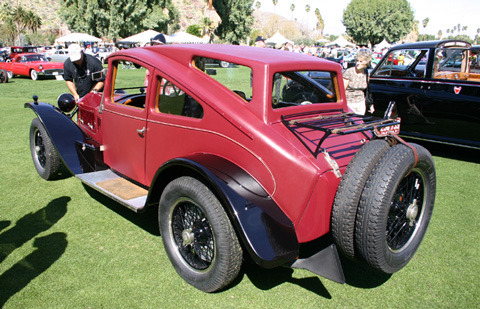
This Lancia Lambda Airway Saloon, bodied by Albany Coachworks, was commissioned by the Olympia Motor Show in London in 1927 to commemorate Lindberg’s solo Atlantic flight earlier in the year. It has many aeronautical features including a pitot tube at the leading edge of the cabin roof for the airspeed indicator. The car was entered by the Byrd family in honor of Gary Byrd, a great enthusiast and one of the world’s foremost Lancia authorities who left us last November. Credit: Michael T. Lynch
The Riverside International Auto Museum and the Robert Pond collection brought seven Gurney Eagle race cars between them. One of the Riverside cars was the Eagle-Chevrolet Mk 5 that Tony Adamowicz drove to the 1968 Formula Continental Championship. Adamowicz was at the event as a judge. Tony competes with the car in vintage racing. Another race car that drew a lot of attention was Ivan Zaremba’s Hudson Hornet, prepared and painted as the car driven by Marshall Teague who won the 1951 and 1952 NASCAR races on the old Daytona Beach course, which ran on city streets and the beach itself. The crowds seemed awed by the variety of cars on display, especially the Fisker Karma, the world’s first luxury plug-in hybrid. This sleek four-door sedan had a polished aluminum body and won the People’s Choice award.
Many in the crowd walked past a rusted chassis without a body displayed by Tom Shaughnessy. Those who cared to inquire found out that what looked like a derelict sled on wheels was a Ferrari with a fascinating story behind it. It was offered on eBay by a seller who didn’t know what it was and sold for $26,000. Experts place its true value well into seven figures, and much higher if restored to its original specification as a factory Le Mans racer.
Another interesting grouping was cars from the late Robert Pond’s collection. Pond was a Minnesota industrialist who retired to Palm Springs and built the Palm Springs Air Museum, which draws over 100,000 visitors yearly. He was also active in charitable causes in the entire region.
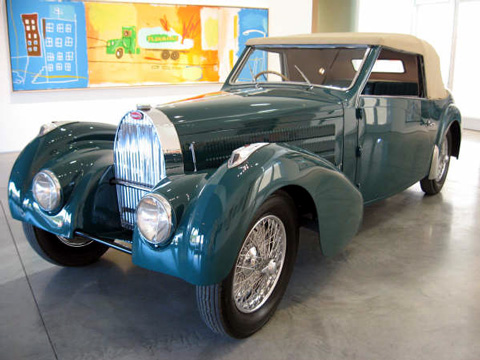
This Bugatti Type 57 Stelvio drophead coupe features a body designed by Jean Bugatti. The car is owned by the estate of noted aircraft and automobile collector, Robert Pond. It is seen here among other works of art at the Heather James Gallery in Palm Desert. The gallery was the site of a lavish reception on Friday evening of the Desert Classic weekend. Credit: Reed Hellyer.
Palm Springs has always had show business connections and there were cars that reflected this, including a Pierce Arrow once owned by studio head Louis B. Mayer and an Austin-Healey 100S that was raced at Sebring and elsewhere by child star and 50s TV stalwart, Jackie Cooper.
After much deliberation, Scott Gauthier’s Alfa Romeo Sprint Zagato Coda Tronca took Best of Show. As the sun sank behind the mountains, people remained, chatting and watching the cars leave the field. No one wanted the day to end.
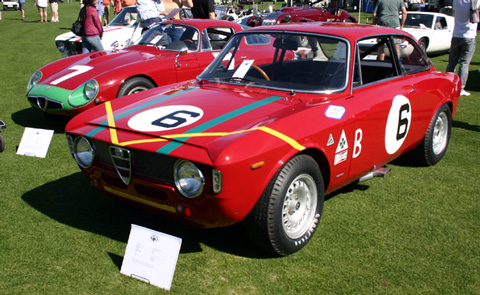
Alfa was the featured marque at the Desert Classic, and here are two beauties. Number 6 is Robert Lee’s GTA that led Alfa to the 1966 Trans Am U2 Championship driven by Horst Kwech and Gaston Andrey. It also won the SCCA B Sedan National Championship runoffs at Riverside that year with Kwech driving. Number 7 is Marnix Dillenius’ GTZ which won Most Significant Alfa Race Car. At the first Monterey Historics in 1974, Marnix used this car to beat all the Cobras and Ferrari GTOs in the 1960s GT race. He has continued to return to Laguna Seca in the 35 subsequent years to show the younger set how to drive a vintage race car. Thanks, Marnix. It’s been time well spent. Credit: Michael T. Lynch
Italian winners not mentioned in the captions included Ken and Dayle Roath’s alloy Ferrari 275 GTB 6C (Ferrari), Bill Pope’s Maserati 6CM (Race Cars) and Paul Emple’s Isotta Fraschini Type 8A Flying Star (European Classic Sports). Dan and Carol Murray’s Alfa 2600 Sprint Zagato coupe won a special award as the best Alfa on the field.
Charity beneficiaries of this year’s event were Animal Samaritans SPCA, the Palm Springs Police Department’s Mounted Enforcement Unit, Desert Samaritans for the Elderly and the Virginia Waring International Piano Competition.
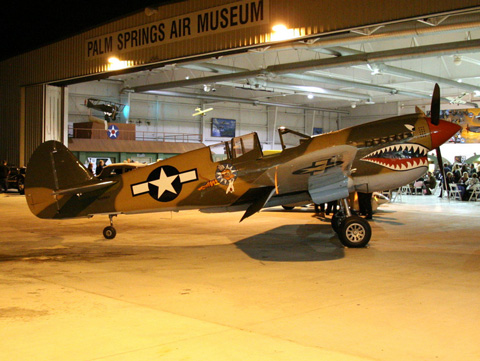
Saturday night’s gala was held at the Palm Springs Air Museum among a fabulous collection of World War II aircraft. This Curtiss P-40 Warhawk is decked out in General Claire Chennault’s Flying Tiger livery. Credit: John Wiley.
The organizers are to be commended for not being cowed by today’s economic conditions and expanding the breadth of what is already one of the most prestigious Western events on the concours calendar. We eagerly await news of their plans for next year.
Doesn’t “coda tonca” more appropriately mean “cut tail” and not “short tail?” Nomenclatures change, but I remember people calling those round-rump eggshaped Zagatos “short tail” and the Kamm-tailed cars, as in the picture, “long tails;” informal descriptions maybe, but back then those were the terms in use.
Toly,
Confusing isn’t it. Well, it really means “clipped tail” but not short tail. Clipped as in cut off abruptly straight across with scissors.
Hence, the long-tail Kamm-ended cars were called Coda Tronca, even though
the earlier version round tail was shorter.
Michael,
Great coverage. You were fortunate enough to be there for all the weekend’s activities, all I could do was cover Sunday’s main event. Paul and Holly Merrigan did a great job in organizing what is a first class event.
I spoke with Scott and Courtney Gauthier before the Best of Show award was given. What a great couple and great custodians of a very special car.
If your readers would like to see more of the cars that caught my eye, I invite you to take a look at both my coverage and my gallery of 48 high-resolution images available at Automotive Traveler.com.
http://automotivetraveler.com/jump/241
Coda Tronca (and not Trunka — as on the link http://automotiveraveller.com/jump/241 — or for that matter Tonca — as above — or Tonka — as in the toy manufacturing company) means “Tail” ( = Coda) and Truncated” ( = Tronca or even better Troncata).
In Italy “Tronchiamo una Discussione” (which would be appropriate here among us “experts”). “Tronchiamo la Discussione” means making an abrupt end to the discussion, much in the manner that Bill O’Reilly often does on the O’Reilly Factor for Fox TV Network in the USA.
“Tronchiamo la Coda”, therefore means in Italian that we cut-off the tail (of a dog, such as a Dobbermann, or a car, such as this Alfa Romeo by Zagato). Hence, “Coda Tronca” does NOT mean short tail, but cut-off tail, as there is no more tail left after the separatio/act has taken place.
Hope this answers all you guys questions and explanations.
Regarding the comments about Exner-era Chrysler Italian bodied cars, I can think of at least 20 Ghia bodied cars off the top of my head. And, regarding nautical accidents, only the Norseman was destroyed, today at the bottom of the sea in the hull of the Andrea Doria. The 1952 C200 was sent by Ghia on the USS Constitution from Genoa and was dropped by dock workers when unloaded in New York. The car suffered minor damage, was quickly repaired, and joined the show circuit. I am not aware of any other Ghia Chrysler cars lost at sea. Perhaps Mr. Lynch has more information on this.
B. Elitch
Healdsburg, CA